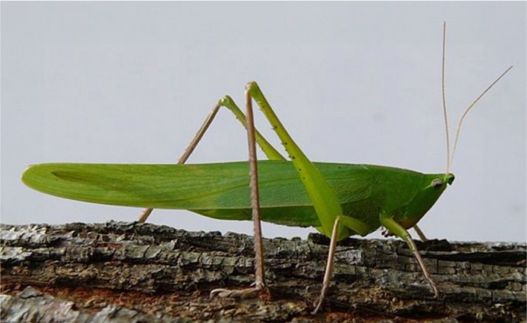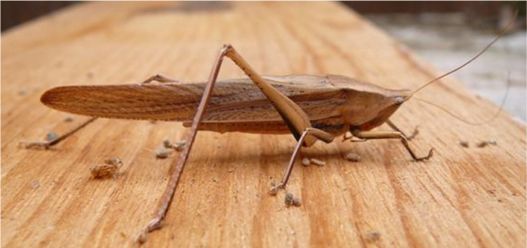 |
Return to Texas Entomology - Compiled by Mike Quinn
 |
(overwintering female, green form)
 |
(overwintering brown form)
Thomas J. Walker is the primary source for the following information.
Range: New Jersey to Florida to southern California. map
Sound: Loud singing begins on warm evenings in late February into April - John Stidham
Habitat:
Calling males are wide spread from ground level to tree tops. Juveniles and feeding adults occur in grassy areas; overwintering adults occur in thickets and woods.
Season: Outside of east Texas, this is the only conehead that overwinters as an adult and starts singing in spring.
Onset of singing and number of broods varies with latitude as seen in this phenological graph
Identification: No other conehead has a cone that is wider than long
Color:
Most summer males and females are green (>80%). Most overwintering males are brown (>95%), but most overwintering females are green (>65%). This is possibly because most overwintering males are short lived where as the females generally survive into early summer. (Whitesell, 1974)
Similar Species:
Common coneheads (Neoconocephalus) have wings that extend beyond the abdomen; the cone is separated from the face by a prominent gap and never ends in a sharp point. Seven species occur in Texas:
Neoconocephalus exiliscanorus slightly musical conehead East Texas July–Sept Neoconocephalus nebrascensis Nebraska conehead East Texas July–Sept Neoconocephalus palustris marsh conehead East Texas July–Oct (rare) Neoconocephalus retusus round-tipped conehead East Texas Aug–Sept Neoconocephalus robustus robust conehead State Wide July–Aug (rare) Neoconocephalus triops broad-tipped conehead All but Panhandle Feb–May Neoconocephalus velox swift conehead Gulf Coast June–July
Photos: Close-up of head green form - Close-up of head brown form - BugGuide.Net
Weblink: broad-tipped conehead - Thomas J. Walker
Etymology: Neoconocephalus triops (Linnaeus 1758)
ne -a -o (G) young, youthful, new, fresh
con -o -us (G) cone
cephal -a -o (G) head
tri (L & G) three
opsa (G) eye
Biography: Carl Linnaeus (1707-1778) - University of California, Berkeley
Bibliography:
Burk, T. 1982. Evolutionary significance of predation on sexually signalling males. Florida Entomologist 65(1): 90-104.
Capinera, J.L. & R.D. Scott, T.J. Walker. 2005. Field Guide to Grasshoppers, Katydids, and Crickets of the United States. Cornell University Press, Ithaca, New York. 280 pp.
Helfer, J.R. 1962. How to Know the Grasshoppers, Cockroaches, and Their Allies. Wm. C. Brown Company, Dubuque. 353 pp.
Josephson, R.K. 1985. The mechanical power output of a tettigoniid (Neoconocephalus triops) wing muscle during singing and flight. Journal of Experimental Biology 117: 357-368.
Taber, S.W. & S.B. Fleenor. 2003. Insects of the Texas Lost Pines. Texas A&M University, College Station. 283 pp.
Whitesell, JJ. 1974. Geographic variation and dimorphisms in song, development, and color in a katydid: field and laboratory studies (Tettigoniidae, Orthoptera). PhD dissertation. University of Florida, Gainesville. 75 pp.
Whitesell, J.J., T.J. Walker. 1978. Photoperiodically determined dimorphic calling songs in a katydid. Nature 274(5676): 887-888.
19 Nov 2008 © Mike Quinn / entomike@gmail.com / Texas Entomology / Katydids of Texas